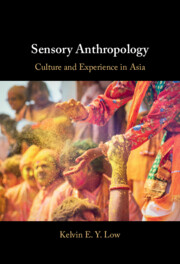Book contents
- Sensory Anthropology
- Sensory Anthropology
- Copyright page
- Dedication
- Contents
- Acknowledgements
- Introduction: How the Senses Are Good to Think With
- Part I Perspectives and Precepts
- 1 Sensory Models and Modalities
- 2 Sensory Moral Economies
- Part II Responses and Restitutions
- Conclusion: Thinking through the Senses
- Notes
- References
- Index
1 - Sensory Models and Modalities
from Part I - Perspectives and Precepts
Published online by Cambridge University Press: 02 March 2023
- Sensory Anthropology
- Sensory Anthropology
- Copyright page
- Dedication
- Contents
- Acknowledgements
- Introduction: How the Senses Are Good to Think With
- Part I Perspectives and Precepts
- 1 Sensory Models and Modalities
- 2 Sensory Moral Economies
- Part II Responses and Restitutions
- Conclusion: Thinking through the Senses
- Notes
- References
- Index
Summary
I ask how sensory models are established and operate across different cultures, including their variant ethnographical nuances. This problematises the interplay of the senses whereby sensory conjunctions or amalgams form part of everyday life and ritual practices in many societies, as opposed to the broader compartmentalisation of the senses in Western aesthetics. The chapter compares a range of categories that delineate different senses, as well as the varying modalities per sense. This is accomplished through an investigation of linguistic descriptors of senses as a starting point. How a particular culture names the senses that wield cultural importance is however not merely an exercise in description or enumeration. I analyse sensory nomenclatures in a three-fold manner to unveil the phenomenological epistemology of the senses. First, I engage with the numbers of modalities per sense in order to acknowledge alternate sensory models beyond the hegemonic Romano–Grecian five-sense categorisation. Second, I query the social significance of the nuances of each sense. Third, I raise examples of how two or more senses may be employed synaesthetically. By focusing on cultural interpretations of sensory practices, pairings, and intersections, this approach sheds analytical attention upon everyday orderings of sensory categories and their cultural significance.
Keywords
- Type
- Chapter
- Information
- Sensory AnthropologyCulture and Experience in Asia, pp. 19 - 52Publisher: Cambridge University PressPrint publication year: 2023



